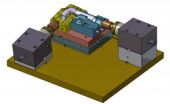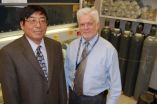(Press-News.org) An intensive early intervention therapy that is effective for improving cognition and language skills among very young children with autism also normalizes their brain activity, decreases their autism symptoms and improves their social skills, a nationwide study has found. The researchers said the study is the first to demonstrate that an autism early intervention program can normalize brain activity.
"We know that infant brains are quite malleable and previously demonstrated that this therapy capitalizes on the potential of learning that an infant brain has in order to limit autism's deleterious effects," said study author Sally Rogers, professor of psychiatry and behavioral sciences and a researcher with the UC Davis MIND Institute.
"The findings on improved behavioral outcomes and the ability to normalize brain activity associated with social activities signify that there is tremendous potential for the brains of children with autism to develop and grow more normally," Rogers said.
Published online today in the Journal of the American Academy of Child & Adolescent Psychiatry, the randomized, case-controlled, multi-centered study titled "Early behavioral intervention is associated with normalized brain activity in young children with autism," found that the children who received the intervention exhibited greater brain activation when viewing faces rather than objects, a response that was typical of the normal children in the study, and the opposite of the children with autism who received other intervention.
The U.S. Centers for Disease Control and Prevention estimates that 1 in 88 children born today will be diagnosed with autism spectrum disorder. Hallmarks of the neurodevelopmental condition include persistent deficits in social communication and relatedness, and repetitive or restrictive patterns of interest that appear in early childhood and impair everyday functioning.
Named the Early Start Denver Model (ESDM), the intervention method was developed by Rogers and Geraldine Dawson, chief science officer of the research and advocacy organization Autism Speaks. The therapy fuses a play-based, developmental, relationship-based approach and the teaching methods of applied behavioral analysis.
"This may be the first demonstration that a behavioral intervention for autism is associated with changes in brain function as well as positive changes in behavior," said Thomas R. Insel, director of the National Institute of Mental Health, which funded the study. "By studying changes in the neural response to faces, Dawson and her colleagues have identified a new target and a potential biomarker that can guide treatment development."
For the present study, the researchers recruited 48 diverse male and female children diagnosed with autism between 18 and 30 months in Sacramento, Calif., and in Seattle, as well as typically developing case controls. The ratio of male-to-female participants was more than 3-to-1. Autism is five times more common among boys than girls.
Approximately half of the children with autism were randomly assigned to receive the ESDM intervention for over two years. The participants received ESDM therapy for 20 hours each week, and their parents also were trained to deliver the treatment, a core feature of the intervention. The other participants with autism received similar amounts of various community-based interventions as well as evaluations, referrals, resource manuals and other reading materials.
At the study's conclusion, the participants' brain activity was assessed using electroencephalograms (EEGs) that measured brain activation while viewing social stimuli -- faces -- and non-social stimuli -- toys. Earlier studies have found that typical infants and young children show increased brain activity when viewing social stimuli rather than objects, while children with autism show the opposite pattern.
Twice as many of the children who received the ESDM intervention showed greater brain activation when viewing faces rather than when viewing objects -- a demonstration of normalized brain activity. Eleven of the 15 children who received the ESDM intervention, 73 percent, showed more brain activation when viewing faces than toys. Similarly, 12 of the 17 typically developing children, or 71 percent, showed the same pattern. But the majority -- 64 percent -- of the recipients of the community intervention showed the opposite, "autistic" pattern, i.e., greater response to toys than faces. Only 5 percent showed the brain activation of typical children.
Further, the children receiving ESDM who had greater brain activity while viewing faces also had fewer social-pragmatic problems and improved social communication, including the ability to initiate interactions, make eye contact and imitate others, said MIND Institute researcher Rogers. Use of the ESDM intervention has been shown to improve cognition, language and daily living skills. A study published in 2009 found that ESDM recipients showed more than three times as much gain in IQ and language than the recipients of community interventions.
"This is the first case-controlled study of an intensive early intervention that demonstrates both improvement of social skills and normalized brain activity resulting from intensive early intervention therapy," said Dawson, the study's lead author and professor of psychiatry at the University of North Carolina, Chapel Hill. "Given that the American Academy of Pediatrics recommends that all 18- and 24-month-old children be screened for autism, it is vital that we have effective therapies available for young children as soon as they are diagnosed."
"For the first time," Dawson continued, "parents and practitioners have evidence that early intervention can alter the course of brain and behavioral development in young children. It is crucial that all children with autism have access to early intervention which can promote the most positive long-term outcomes."
Rogers, Dawson and Laurie J. Vismara, also a researcher with the MIND Institute, have authored two books on the intervention. One for professionals is titled "Early Start Denver Model for Young Children with Autism: Promoting Language, Learning, and Engagement" and one for parents titled "An Early Start for Your Child with Autism: Using Everyday Activities to Help Kids Connect, Communicate, and Learn."
The ESDM intervention is available in Sacramento through the MIND Institute clinic and in a number of locations throughout the U.S. and other nations. Training in delivering the ESDM method is provided through the MIND Institute and the University of Washington.
### Other study authors include Emily J.H. Jones, Kaitlin Venema, Rachel Lowy, Susan Faja, Dana Kamara, Michale Murias, Jessica Greenson, Jamie Winter, Milani Smith and Sara J. Webb, all of the University of Washington, and Kristen Merkle of Vanderbilt University.
The study was funded by a grant from the National Institute of Mental Health and by a postdoctoral fellowship to Jones from Autism Speaks.
Autism Speaks is the world's leading autism science and advocacy organization. It is dedicated to funding research into the causes, prevention, treatments and a cure for autism; increasing awareness of autism spectrum disorders; and advocating for the needs of individuals with autism and their families.
At the UC Davis MIND Institute, world-renowned scientists engage in collaborative, interdisciplinary research to find the causes of and develop treatments and cures for autism, attention-deficit/hyperactivity disorder (ADHD), fragile X syndrome, 22q11.2 deletion syndrome, Down syndrome and other neurodevelopmental disorders. For more information, visit mindinstitute.ucdavis.edu
Autism early intervention found to normalize brain activity in children as young as 18 months
2012-10-26
ELSE PRESS RELEASES FROM THIS DATE:
Feinstein Institute researchers discover that bean used in Chinese food could protect against sepsis
2012-10-26
MANHASSET, NY – Researchers at The Feinstein Institute for Medical Research have discovered that a bean commonly used in Chinese cuisine protects against the life-threatening condition sepsis. These findings are published in the current issue of Evidence-based Complementary and Alternative Medicine (eCAM).
It has been found that a deoxyribonucleic acid (DNA) protein, HMGB1, mediates inflammation. Inflammation is necessary for maintaining good health – without inflammation, wounds and infections would never heal. However, persistent and constant inflammation can damage ...
Results of the XIMA trial presented at TCT 2012
2012-10-26
MIAMI, FL – OCTOBER 26, 2012 – Rarely tested in patients over the age of 80, a study found that drug-eluting stents exhibited some benefits over bare-metal stents, though both types of stents demonstrated a clinical benefit. Results of the XIMA trial were presented today at the 24th annual Transcatheter Cardiovascular Therapeutics (TCT) scientific symposium. Sponsored by the Cardiovascular Research Foundation (CRF), TCT is the world's premier educational meeting specializing in interventional cardiovascular medicine.
Patients over the age of 80 are often excluded from ...
Cost-effective titanium forming
2012-10-26
To all intents and purposes, nothing stands in the way of titanium in terms of becoming a first-choice industrial material. It is a practically unlimited resource; it is stable and lightweight, but also extremely malleable as well as corrosion and temperature resistant. Nevertheless, this white silver lustrous metal remains in the shadows of steel, chrome, nickel and aluminum when it comes to manufacturing. The reason for this is that efficient metal forming processes such as deep drawing or hydroforming can only be used in a very limited way. "Titanium tends to adhere ...
A Viagra follow-up? Drug used to treat glaucoma actually grows human hair
2012-10-26
If you're balding and want your hair to grow back, then here is some good news. A new research report appearing online in The FASEB Journal (www.fasebj.org) shows how the FDA-approved glaucoma drug, bimatoprost, causes human hair to regrow. It's been commercially available as a way to lengthen eyelashes, but these data are the first to show that it can actually grow human hair from the scalp.
"We hope this study will lead to the development of a new therapy for balding which should improve the quality of life for many people with hair loss," said Valerie Randall, a researcher ...
Anesthesia type affects outcomes of bilateral knee replacement surgery
2012-10-26
Using regional anesthesia rather than general anesthesia reduces the need for blood transfusions in patients undergoing bilateral total knee replacement, according to a new study by researchers at Hospital for Special Surgery, in New York City.
Currently, the majority of bilateral knee replacements in the United States (as well as single knee replacements) are performed under general anesthesia, and researchers say that a regional anesthesia known as neuraxial anesthesia should be promoted for these procedures.
"The use of neuraxial anesthesia may not always be feasible ...
Glass: Characterizing with precision and efficiency
2012-10-26
At home, in the car or with industrial processes – glass is a universal material. Its properties are so extraordinary that frequently there are no alternatives to this material. Take, for example, high-temperature fuel cells, in which layers of ceramics and metals are alternately attached to each other: to ensure no explosive hydrogen escapes, the metal and ceramic layers must be firmly bound to each other, and the seam must be sealed tight. Only glass can accomplish this type of seal – and here, we are specifically referring to solder glass. But how does glass behave at ...
Scientists step up hunt for bacterial genes tied to Lyme disease
2012-10-26
Investigators at The University of Texas Health Science Center at Houston (UTHealth) have accelerated the search for the bacterial genes that make the Lyme disease bacterium so invasive and persistent. The discovery could advance the diagnosis and treatment of this disease, which affects an estimated 30,000 Americans each year.
The researchers have developed a new technique that allowed them to test 15 times more bacterial genes than had been evaluated in the previous 30 years to ascertain their roles in infection. Findings appeared Oct. 25 in the journal The Public Library ...
Hermit crabs socialize to evict their neighbors
2012-10-26
Social animals usually congregate for protection or mating or to capture bigger prey, but a University of California, Berkeley, biologist has found that the terrestrial hermit crab has a more self-serving social agenda: to kick another crab out of its shell and move into a larger home.
All hermit crabs appropriate abandoned snail shells for their homes, but the dozen or so species of land-based hermit crabs – popular terrarium pets – are the only ones that hollow out and remodel their shells, sometimes doubling the internal volume. This provides more room to grow, more ...
NASA sees Tropical Storm Son-tinh moving through South China Sea
2012-10-26
NASA's Terra satellite got a good look at Tropical Storm Son-tinh moving through the South China Sea and headed for landfall in Vietnam.
NASA's Terra satellite flew over Son-Tinh on Oct. 26 at 0305 UTC (Oct. 25 at 11:05 p.m. EDT) and the Moderate Resolution Imaging Spectroradiometer (MODIS) instrument aboard captured a visible image of the storm. At the time, Son-tinh's western edge had already moved away from the Philippines. The image revealed powerful thunderstorms in the northwestern quadrant of the storm, and in the storm's center.
On Oct. 26 at 1500 UTC, Tropical ...
Drug shows promise in animal model of Alzheimer's and Parkinson's with dementia
2012-10-26
New research presented in October at the 6th Neurodegenerative Conditions Research and Development Conference in San Francisco demonstrates the role of the investigational compound IRX4204 in alleviating cognitive decline in animal models of Alzheimer's disease (AD). The presentation entitled "Investigation of the RXR-specific agonist IRX4204 as a Disease Modifying Agent of Alzheimer's Disease Neuropathology and Cognitive Impairment" was made by lead researcher Giulio Maria Pasinetti, MD, PhD, of the Mount Sinai School of Medicine in New York City.
IRX4204 is a retinoid ...




